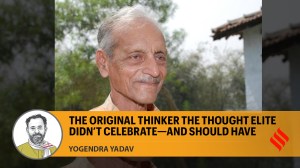Farmers’ Column | A smart farmer shows the way with his smartphone: ‘If we take care of our soil, it will take care of us’
Pargat Singh, 33, began his career with Vedanta’s TCPL core company after completing his engineering in 2015. But something was missing. By the end of 2017, he returned to his roots — his family’s then 20-acre farmland.
 Pargat's YouTube channel, Crop’s Information, has over five lakh subscribers, 1.6 lakh followers on Instagram, and millions of views across platforms. (Screenshot: YouTube/@cropsinformation)
Pargat's YouTube channel, Crop’s Information, has over five lakh subscribers, 1.6 lakh followers on Instagram, and millions of views across platforms. (Screenshot: YouTube/@cropsinformation)In a quiet corner of Punjab’s Bathinda district, in the village of Gehri Bhagi, a quiet revolution is taking place — one that doesn’t involve protests, political platforms, or subsidies. It’s happening through a smartphone camera, a deep understanding of soil, and one farmer’s resolve to change the way India grows its food. He is also bridging the gap between farmers and agricultural experts by taking farmers’ questions to the experts and their answer to the farmers.
Pargat Singh, a 33-year-old engineer-turned-farmer, who, under the Golden Heart Scholarship Scheme for rural meritorious students, completed his BTech in Electronics and Communication from Yadvindra College of Engineering, Talwandi Sabo (under Punjabi University). He has become a household name among the country’s most progressive cultivators. Through nearly 1,900 YouTube videos — each grounded in field-level experimentation and everyday farming challenges — he has become one of the most powerful grassroots agricultural educators in India, especially in a country where agriculture extension services remain inadequate and inaccessible to many.
His YouTube channel, Crop’s Information, has over five lakh subscribers, 1.6 lakh followers on Instagram, and millions of views across platforms. But beyond the numbers lies a mission: to enrich India’s soil — and its farmers — by reducing input costs, increasing productivity, and restoring soil health through sustainable practices.
“Soil enrichment is the foundation. If we take care of our soil, it will take care of us,” says Pargat, standing on his meticulously managed 22-acre model farm.
Pargat began his career with Vedanta’s TCPL core company after completing his engineering in 2015. But something was missing. By the end of 2017, he returned to his roots — his family’s then 20-acre farmland.
“There has been no stubble burning on our fields since I began farming in 2016–17. I started getting regular soil tests. Back then, the Organic Matter (OM) in my soil was just 0.25% —among the lowest fertility levels. After eight years of care, it has now increased to 0.85%,” he says.
Pargat’s goal? To take his soil’s OM to 5% — a level that transforms barren land into a self-sustaining ecosystem.
“In parts of the world, OM reaches 10% — where just seed and water can produce peak yields — but it takes several decades to enrich soil’s OM from less than a per cent to 10%. We’re far from that, but even reaching 2–3%, which is international standard of OM, in Punjab would revolutionise productivity and reduce our dependence on costly inputs,” he adds.
In Punjab, OM presence in the majority of soils was 0.40% during the Green Revolution in 1966–67, and it has only increased to 0.51% at present. In the more than 50 years since, OM has risen merely by 0.11%.
Pargat is often asked about his bold claim that a farmer can earn Rs 40 lakh per acre per annum. “People laugh, call it utopian. But I’ve met farmers earning Rs 1 crore per acre, especially with multilayered and vertical farming. The challenge is to replicate such models in our conditions — soil types, climate, and farmer mindset,” he says.
He believes that with localised planning, optimised soil health, and modern techniques, an average income of Rs 4–8 lakh per acre is not just achievable — but replicable. For that, however, the mindset of farmers must shift, and nothing drives that shift better than practical, field-tested examples — the kind he demonstrates in his videos to thousands of farmers connected with him now.
Currently, most farmers earn just Rs 70,000 to Rs 90,000 per acre annually from wheat and paddy after meeting expenses. “Even wheat and paddy income can be increased if the soil is enriched. For that, farmers must stop burning stubble in their fields. Rather, they should incorporate it into their soil to enhance fertility,” says Pargat.
In 2017, as 3G internet trickled into Punjab’s villages, Pargat uploaded his first video — on how to maintain a rotavator, a machine used for preparing the soil and creating an ideal seedbed for planting by improving drainage and moisture retention after wheat sowing.
“I had no idea farmers were even watching such content. But the response was overwhelming,” he recalls. That led to his second video — on nutrient deficiencies like magnesium, copper, and zinc, and how they affect crop yield.
That was the beginning of a relentless journey in digital agri-education. Today, his channel hosts over 1,890 videos covering soil health, seed selection, irrigation, machinery, stubble management, nutrient cycles, water management, and post-harvest care etc.
In a country where agriculture extension officers are a few and often disconnected from the field, Pargat has filled the vacuum. He has personally visited 142 villages across Punjab and India, often travelling over 800 km at his own expense, documenting on-field practices, soil testing, machinery trials, farmer experiences, and expert interviews. His content isn’t theoretical— it’s based on real-world experimentation.
“I never promote what I haven’t tried and experienced myself. From stubble management to micronutrient applications, everything I share has been tested on my own fields first,” he says.
His 22-acre farm (2.5 acres purchased in the last five years) is a sustainability model — paddy on 20 acres, cotton on two, and fodder on half an acre. He rotates crops with wheat, mustard, sugarcane, and turmeric, all while preserving soil health. He has avoided stubble burning since 2016 by using a Happy Seeder, reducing wheat sowing costs to Rs 1,000 per acre while achieving 27.5 quintals per acre for wheat and 36 quintals per acre for paddy — all while keeping input costs under Rs 20,000 per acre for both crops collectively — far below the regional average.
Author, researcher, and farmer psychologist, Pargat has also written two well-received books on major crops of Punjab and India. One on cotton, “Narma Assan Di Chitti Dheri” (July 2021)— a cotton farming manual dedicated to farmers battling debt and mental health crises. And the second on paddy, “Chona Beej Ton Beej Tak Da Safar” (June 2023) — a paddy guide that demystifies myths about water usage and soil health, and dives deep into carbon cycles and stress indicators often ignored by traditional agri-extension departments.
These works, like his videos, aim to bridge the gap between academic research and field application.
Pargat provides more than videos; building a digital ecosystem for farmers is the main aim through Crop’s Information. His platform offers free consultation, online and offline training, a marketplace for seeds, fertilizers, and tools, and a peer-to-peer network for farmer collaboration and consultancy services linked to six–seven agricultural universities. “I am also bridging the gap between farmers and universities by taking farmers’ questions to the university experts and their answer to the farmers,” he says.
He even introduced global techniques — like those seen in Texas farm expos — tailoring them to Indian soil conditions, a key missing link in imported solutions.
Despite his growing popularity, Pargat remains deeply grounded. He stores his own seeds, monitors every stage of his crop cycles, and plans his cultivation around soil conservation and water efficiency. “Every farmer must know the science of their soil, the stress indicators of their crops, and the weight of their seed. Farming by hearsay is no longer sustainable,” he warns.
His impact hasn’t gone unnoticed. “He’s doing what the Punjab Agriculture Department and even Punjab Agricultural University have failed to do at scale,” admits a senior officer from the state agriculture department.
With over 5.76 crore views and a vast, growing community of farmers, Pargat’s digital revolution is quietly reshaping Indian agriculture — one acre, one video, and one soil test at a time.
“In farming, you have to stay ahead — but also stay rooted,” he says.







